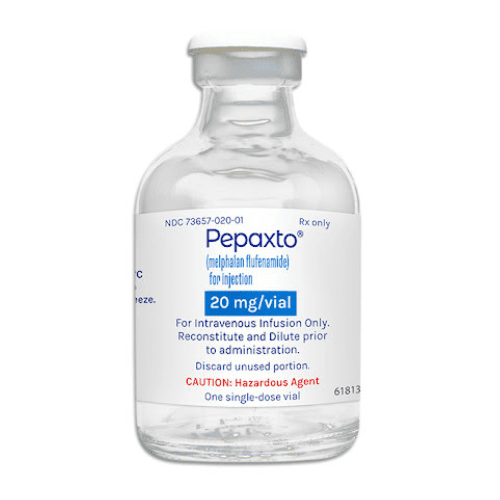Melphalan flufenamide Disease Interactions
There are 3 disease interactions with melphalan flufenamide.
Antineoplastics (applies to melphalan flufenamide) infections
Major Potential Hazard, Moderate plausibility. Applicable conditions: Infection - Bacterial/Fungal/Protozoal/Viral
Because of their cytotoxic effects on rapidly proliferating tissues, antineoplastic agents frequently can, to varying extent, induce myelosuppression. The use of these drugs may be contraindicated in patients with known infectious diseases. All patients should be instructed to immediately report any signs or symptoms suggesting infection such as fever, sore throat, or local infection during antineoplastic therapy. Close clinical monitoring of hematopoietic function is recommended.
Melphalan flufenamide (applies to melphalan flufenamide) bone marrow suppression
Moderate Potential Hazard, Moderate plausibility. Applicable conditions: Bone Marrow Depression/Low Blood Counts
Bone marrow suppression is the most significant toxicity associated with melphalan flufenamide in most patients. It is recommended to perform the following tests at the start of therapy and prior to each subsequent dose of melphalan flufenamide: platelet count, hemoglobin, white blood cell count, and differential. Thrombocytopenia and/or neutropenia are indications to withhold further therapy until the blood counts have sufficiently recovered. Monitor blood counts frequently to determine optimal dosage and to avoid toxicity. Consider prophylactic therapy such as leukocyte growth factor as clinically appropriate. Dose adjustment on the basis of blood counts at the nadir and day of treatment should be considered.
Melphalan flufenamide (applies to melphalan flufenamide) renal dysfunction
Moderate Potential Hazard, Moderate plausibility.
No dose adjustment of melphalan flufenamide is recommended in patients with creatinine clearance (CrCl) 45 to 89 mL/min. Care should be exercised when using this agent in patients with CrCl 15 to 44 mL/min as the safety and efficacy has not been studied in these patients.
Switch to professional interaction data
Melphalan flufenamide drug interactions
There are 268 drug interactions with melphalan flufenamide.
More about melphalan flufenamide
- melphalan flufenamide consumer information
- Check interactions
- Compare alternatives
- Latest FDA alerts (1)
- Side effects
- Dosage information
- During pregnancy
- Drug class: alkylating agents
Related treatment guides
Drug Interaction Classification
| Highly clinically significant. Avoid combinations; the risk of the interaction outweighs the benefit. | |
| Moderately clinically significant. Usually avoid combinations; use it only under special circumstances. | |
| Minimally clinically significant. Minimize risk; assess risk and consider an alternative drug, take steps to circumvent the interaction risk and/or institute a monitoring plan. | |
| No interaction information available. |
See also:
Further information
Always consult your healthcare provider to ensure the information displayed on this page applies to your personal circumstances.


